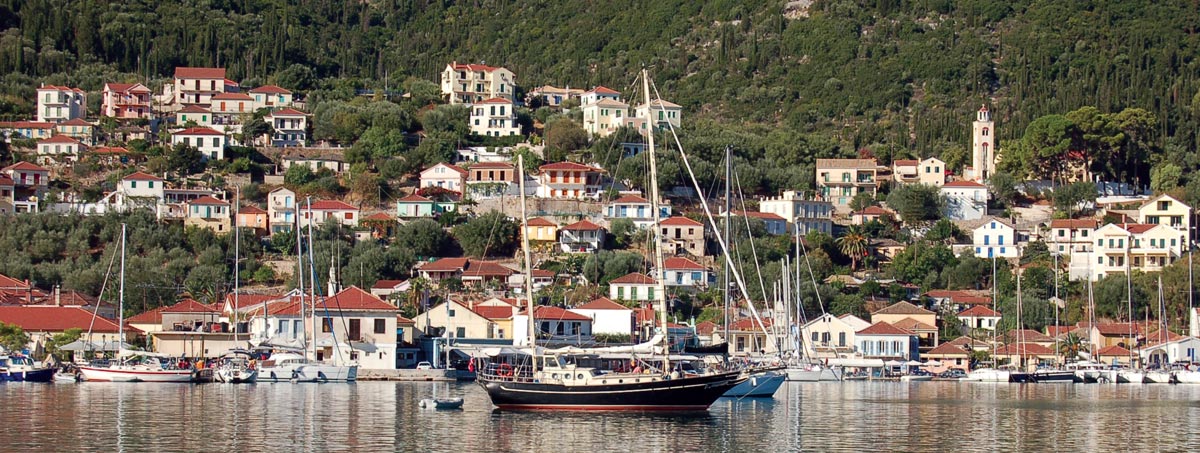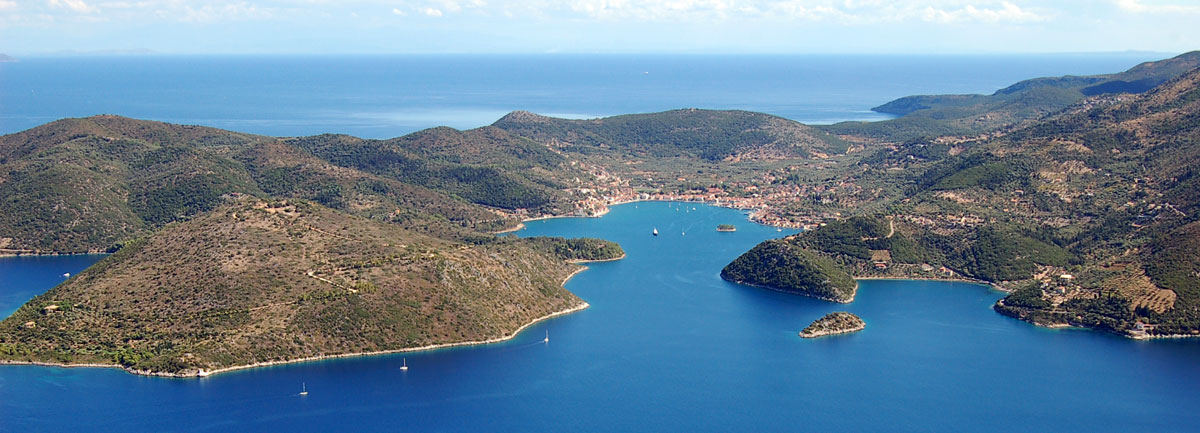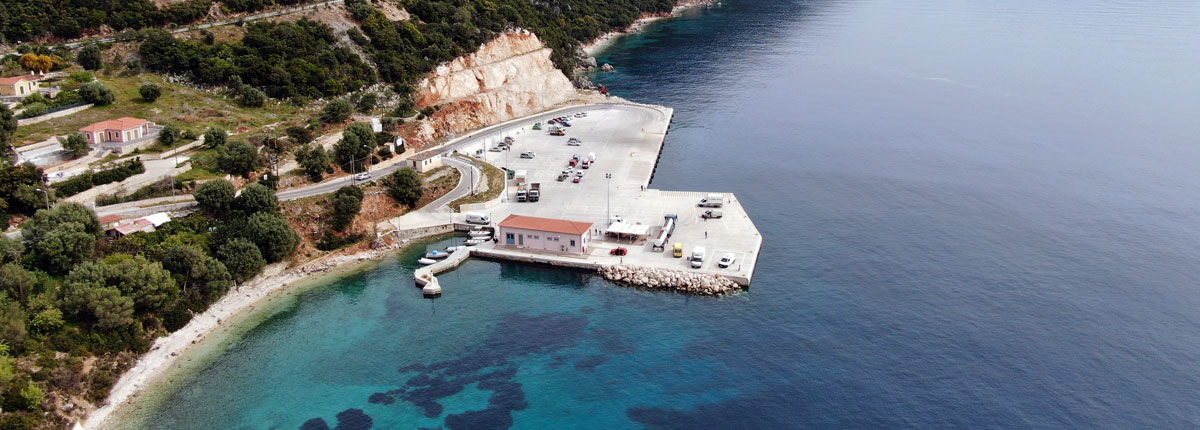
According to Greek Mythology, it took its name from Ithaca, son of Poseidon and Amfiali, the first inhabitant of the island. According to other views, its name came from the word “Ithi” (cheerful) or from the word “Ithis” (steep).
In the period of the Early Helladic civilization (3000 – 2000 BC) are the first traces and findings of inhabitants on the island dated. Unfortunately, there is insufficient evidence for their origin.
During the Mycenaean period (1500 – 1000 BC), Ithaca reached its peak and became the capital of Kefallinia. The residential relics of Mycenaean pottery state that Mycenaeans had settled in Ithaca during the 14th century BC. The kingdom of Ithaca included the surrounding islands as well as part of Mainland Greece. The Ithacans were great sailors and explorers throughout the Mediterranean Sea.
Most historians believe that present-day Ithaca was the island of Odysseus described in Homer’s Iliad and Odyssey. One of the elements in favor of this view is that a prehistoric acropolis with partially preserved parts of a cyclopean wall was identified at the site of Agios Athanasios in northern Ithaca. The palaces, inside, are similar to those of Mycenae. A second element that claims that Ithaca is the island of Odysseus is the topographic study of the island. A rocky isthmus, about 800 m wide, divides the island into two mountain ranges, known from Homer as Nion and Neriton. In 1000 BC. the decline of Ithaca began. Its inhabitants neglected it because it was not a fertile element that justifies the Homeric adjectives “trachea”, “abnormal” and “rocky”.
During the period of Roman rule, Ithaca was a province of Illyria, while in the Byzantine period the Christian religion was established. The island was successively invaded by Vandals, Goths, Visigoths and Saracens. The Medieval period lasted for 300 years after the island was occupied by the Normans.
The Venetian occupation began after the withdrawal of the Tokos (Florentine princes) to be later occupied by the Turks who killed, looted and finally left with many prisoners. Ithaca was deserted at that time as many of the survivors abandoned it. Eventually Ithaca, Kefalonia and Zakynthos came back to the Venetians. The Venetians offered land and tax exemption for five years to the inhabitants to stay on the island but also to attract inhabitants from the nearest areas. Ithaca during the Venetian period can be considered a semi-independent island. It was also the only island where there were no aristocrats or class differences.
With the predominance of the French Revolution, the Ionian Islands fell to the French. They were administratively divided and the prefecture of Ithaca was created, which included Kefalonia, Lefkada and areas of Mainland Greece. The French were smoothly succeeded by the Russians and the Turks and the Ionian state was founded with Corfu as its capital. At the beginning of the nineteenth century, Ithaca and the Ionian Islands returned to French occupation for two years, to be conquered by the British along with all the Ionian islands.
During the period of the Greek revolution against the Turks, many militants, but also a civilian population from Central Greece, found refuge in Ithaca. Several Thiakoi (as the inhabitants of Ithaca were named at the time) participate in the army and the fleet, while twenty-seven Thiakoi are mentioned among the founding members of the Friendly Society. After the decision, England gave a gift to Greece in the Ionian Islands because the sister of the new Greek king, Alexandra of Denmark, had married Prince Edward of Wales, heir to the English throne. Great Britain, France, Greece and Russia signed the “Treaty of London” which established the Ionian Islands as a Greek province.
Vathy

It is also called Ithaca and is the capital of the island. It is located at the bottom of a bay that forms a natural harbor. The name “Vathi” is due to the fact that its bay is surrounded by high mountains and hills, among which the highest mountain of Ithaca, Niritos. Vathi is identified with the ancient port of Forkynos, where according to Homer, the god of the Forki Sea had his sanctuary and where the Phaeacians left Odysseus asleep.
Vathy was first inhabited in the 17th century, as earlier pirate attacks made this impossible. Most of the city was destroyed by the earthquakes of 1953 and rebuilt, but retaining its traditional Ionian architecture. The entrance to this beautiful natural harbor is still guarded by sections of a small fort with two cannons, built during the second French occupation, above the beach of Loutsa.
Approaching the waterfront is the Navy Monument. The history of Ithaca is identified with its naval tradition, through its Naval Schools and trade. In the town square there is the dual statue of Odysseus and the evocative bust of Homer. There are two museums in Vathi. The first is the Archaeological Museum of Vathi Ithaca. It houses important findings from the excavations that took place mainly in South Ithaca, the area of Aetos, from the Geometric to the Roman years. The second museum is the Naval – Folklore Museum of Ithaca, with a rich collection of objects, offered by the Ithacans, in order to preserve their cultural heritage. It is housed on the site of the old Electricity Generation Factory, which supplied electricity to Vathi and Perachori. After the rearrangement of the space and its exhibits, it is ranked among the best Folklore Museums in the country.
A short distance from Vathi there is the famous Cave of the Nymphs (or Marble Cave), at an altitude of 190 m. above the bay of Dexa. According to the location and shape of the cave, it is identified with the Homeric cave where the Phaeacians left Odysseus asleep and where Odysseus later left the gifts of the Phaeacian king Alcinous. The findings of the archeological excavations are exhibited in the Archaeological Museum of Ithaca, in Vathi.
Beaches of the area which are offered for swimming in clear waters, are Loutsa, Dexa, Sarakiniko, Filiatro, Gidaki. Many consider it as the most beautiful beach of Ithaca. Access is either by sea from Vathi or on foot following the path that starts from Skinos. In both cases there is a need for about 25 minutes.
South of the settlement, the bay of Andri is identified with the First Coast, where Telemachus landed on his return from Pylos. Panagia Spiliotissa (or Panagia in Spilies) is a chapel above Andri, the southernmost bay of Ithaca, built in a small cave on the mountain slope. Here the old inhabitants of Ithaca, with simplicity and popular piety, closed the opening of a small cave by building the facade of the church.
Monoliths of Anogi. They are impressive formations of vertical giant monoliths, placed on the rhizomes of other rocks, with strong characteristics of prehistoric megalithic monuments. In addition, high in the col of Mount Niritos NW of Anogi, a total of twelve smaller boulders of various shapes and sizes have been counted.
Early Helladic Settlement of Pelikata. The area “Pelikata”, north of Stavros, where the archaeological museum of North Ithaca is located, is a declared archeological site, due to the existence of remains of a settlement from the Early Helladic and Mycenaean period. The total perimeter of the above space occupies 750 square meters. According to the research of this school, it seems that the center of the kingdom of Odysseus at that time was in the area of the Cross. The findings of the excavations are exhibited in a showcase of the Archaeological Collection of Stavros.
Archaeological site of Agios Athanasios-Homer School. According to the excavation archaeologists, the building complex dates back to the prehistoric period. The building complex was in use at least until the Hellenistic era, as evidenced by its various architectural parts, such as the Hellenistic tower. During the Roman period the site was used as a cemetery.
The archeological site was destroyed by the earthquakes of 1953, it cannot be visited until the necessary works are carried out for the preservation and protection of the discovered monuments, but it has given some of the most important archeological findings of Ithaca such as the famous “EUCHEIN ODYSEI” of the 2nd century BC, which is kept in the museum of Stavros village.
Pisaetos

It’s the wider area that extends southwest of Aetos and the bay with the beach and the port of Piso Aetos. Today, renovation works are being carried out in the port.
At a distance of about 4 km in the area of Aetos, is located the ancient city of Ithaca, which in Hellenistic times was called Alalkomenes. The inscription states that it is the city of the Alalcomenes, however Schliemann had claimed that it was the palace of Odysseus. It is more likely to be a post-Odyssey city. The only sure thing is that this is an ancient Acropolis with great views. The ancient coins found here with the heads of Odysseus and Athena are on display at the Archaeological Museum in Vathi.
Brosta Aetos. The beach of Brosta Aetos is located just below the road that connects Vathi with the villages of northern Ithaca. Large in length and protected at the bottom of the homonymous bay, it offers a calm sea with green waters.
Polis

It is located below Stavros, the main village of northern Ithaca. It is a leeward port, an anchorage for fishing boats in the area.
The strange name of the beach originated from the ancient state which according to tradition is submerged in the waters of the bay. According to this tradition, the city of “Jerusalem” that was located here was sunk by a great earthquake in the eighth century.
On the north side of the harbor is the Homeric Cave of Loizos (who found many archeological finds in it and indicated its location to Schliemann). The cave was destroyed over the years and now only its entrance is visible.
Frikes

The village began to be inhabited from the 16th century, when residents of the surrounding mountainous areas used the natural harbor for fishing needs and mainly for trade with Lefkada and mainland Greece. According to researchers, the Homeric port of Reithro is located there. This is the port where the Goddess Athena took the form of Odysseus’ dear friend, Menti, king of the Tilevoid islands. She anchored her ship in this port and arrived at the palace to advise Telemachus. Frikes are also connected to the modern history of the island, where at the end of World War II, on September 13, 1944, local guerrillas, after an unequal battle, captured the German warship “Antoinette” which was anchored in the small port and captured its crew.
It attracts a large number of sailboats, while it is considered as an ideal starting point for escapes to the beautiful nearby beaches, but also for escapes to the north coast of the island.
In the gulf of Frikes, due to the strong local northwest wind, which blows during the summer, ideal conditions for sailing and windsurfing prevail.
The main attraction of the village are the two well-preserved windmills, located on both sides of the port.
Kioni

It is a village built amphitheatrically, starting from above, from Rachi and reaches the closed, picturesque port. It was inhabited in the 16th century by the inhabitants of the surrounding mountainous areas.
Entering the beautiful cove of Kionios, the visitor faces the preserved traditional settlement. Its captain’s houses testify to the impressive architectural influence of both the Venetians and the English. At the entrance of the port there are three windmills that are lit at night. In Kioni it is worth watching the sunrise.
To its left is the small cove of Mavrouna, a small refuge for small fishing boats. In this area, the monastery of Ai-Nikolas operated in the last century, while today there is only its small church, in the sanctuary of which an ancient capital is preserved. It is said that in the middle of the 17th century, after a fierce battle, the locals defeated the pirates.
On July 20, the festival of Ai Lias takes place, where small fishing boats transport the inhabitants to the small chapel, which is located just outside the port, while at night on the beach there is a festival on the beach.


